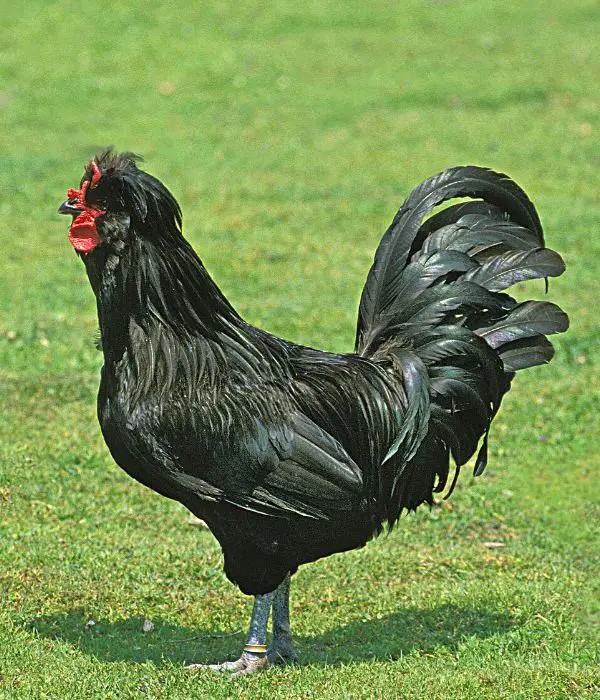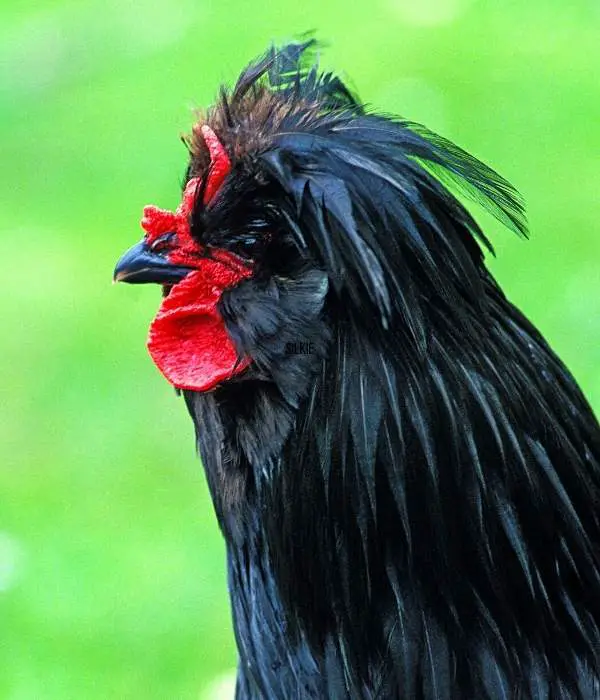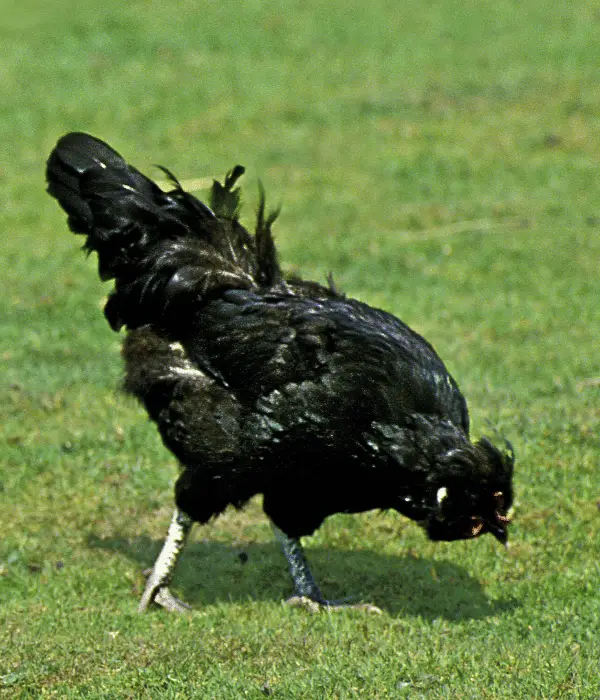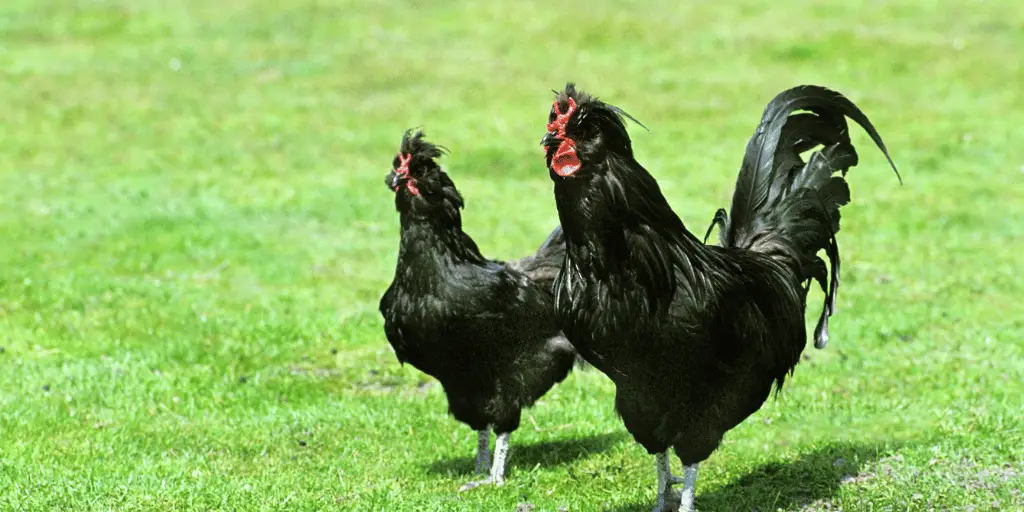Welcome to the world of Crevecoeur chickens, an elegant and rare breed that you will find fascinating.
Crevecoeur are a heritage chicken breed known for their unique appearance, exciting history, and wonderful personality.
If you are considering adding this breed to your flock or want to learn more about them, this guide is for you.
This comprehensive guide will discuss the history and origin of Crevecoeur chickens, their characteristics, colors, size, and much more.
We will also delve into crucial aspects of raising and caring for these magnificent birds and their availability, price, and potential health issues.
Finally, we will answer frequently asked questions to enhance your understanding of the breed further. So sit back, relax, and explore the enchanting world of Crevecoeur chicken breed together.
History and Origin of Crevecoeur Chickens
Crevecoeur chickens originated in France, more specifically from the Normandy region. The breed’s name is derived from the village of Crève-Cœur-en-Auge, believed to have been first developed.
The Crevecoeur chicken breed has a long history that dates back to the 17th century, making them one of the oldest French breeds.
Crevecoeur chickens were thought to be created by crossing local French fowl with birds imported from the Middle East and Africa.
The result was a unique and striking breed that quickly gained popularity. In the 19th century, Crevecoeurs were highly regarded for their meat and egg production and their ornamental value.
However, the breed’s popularity declined during the 20th century due to the rise of commercial chicken farming and the preference for more productive breeds.
Crevecoeur chickens are considered a rare and endangered breed, with efforts being made to preserve and promote their unique heritage.
Why Is Crevecoeur One of the Rare Chicken Breeds?

Crevecoeur chickens have become a rare breed for several reasons. First, their unique appearance and relatively low productivity compared to other commercial breeds have made them less popular among modern farmers.
World War II significantly impacted the breed’s population, as many flocks were destroyed during the conflicts.
Finally, the globalization of the poultry industry has led to a focus on a few commercial breeds that are considered more efficient in terms of meat and egg production.
This has resulted in a decline in the population of many heritage breeds, including Crevecoeur chicken breed.
Despite these challenges, dedicated breeders and enthusiasts continue to work towards preserving and promoting this beautiful and unique breed.
Lifespan of Crevecoeur Chickens
The lifespan of Crevecoeur chickens is typically similar to that of other chicken breeds, averaging around 6 to 8 years.
However, many factors can influence the lifespan of individual birds. Genetics play a role in determining how long a Crevecoeur chicken may live.
Birds from healthy breeding stock with robust genetics tend to have a better chance of living longer lives. Proper nutrition, access to clean water, and a suitable living environment also contribute to their overall well-being and lifespan.
Other factors that can impact lifespan include the level of care provided, the presence of predators or diseases, and the management practices implemented by the chicken keeper.
Crevecoeur Chicken Color Varieties
The American Poultry Association (APA) recognizes only one color variety for Crevecoeur chickens: black. These birds look striking, with glossy black feathers and an iridescent green sheen.
Their unique head features, such as the crest, beard, and black coloration, make Crevecoeurs an eye-catching addition to any flock.
While the black Crevecoeur is the only recognized color variety, there have also been reports of blue Crevecoeur chickens.
However, this color has yet to be officially recognized by the APA, and Blue Crevecoeur is considered extremely rare.
If you come across a blue Crevecoeur, it may result from enthusiasts’ breeding efforts or simply a rare genetic variation.
Characteristics of the Crevecoeur Breed
Crevecoeurs are known for their unique and distinctive appearance. They have a compact body with a broad chest, and their plumage is soft and tight-fitting.
One of the most striking features of the breed is the head, which is adorned with a large, rounded crest of feathers that cover most of the face.
Additionally, Crevecoeur chicken breed have a small V-shaped comb and wattles that are often hidden by their crest.
Other notable features of Crevecoeur chickens include their white earlobes, dark horn-colored beak, and slate-blue legs. They have five toes on each foot, a rare trait among chicken breeds.
When it comes to size, Crevecoeur chickens are considered medium-sized birds, with roosters weighing around 8 lbs and hens weighing approximately 6.5 lbs.
Crevecoeur Chicken Personality and Temperament

Crevecoeur chickens are known for their friendly and docile temperament. They are generally easy to handle and enjoy human interaction, making them an excellent choice for families with children.
Despite their calm nature, Crevecoeur chickens are also quite active and enjoy foraging for food. They are intelligent birds that can adapt well to various living situations, including free-range and confined environments.
While Crevecoeur roosters can be more assertive than the hens, they are mostly not aggressive towards humans or other flock members.
However, monitoring their behavior and ensuring they are not causing undue stress to the rest of the flock is essential.
Crevecoeur Chicken Egg Production
Crevecoeur hens begin laying eggs at around six months of age. They are moderate egg layers, producing approximately 120 to 150 medium-sized eggs annually.
The eggs are cream-colored, sometimes with a slight tint of brown. While their egg production may be lower than some commercial breeds.
Crevecoeur hens are valued for their high-quality eggs, known for their rich flavor and excellent baking properties.
Regarding broodiness, Crevecoeur hens have a moderate tendency to go broody. While this can sometimes disrupt egg production, it also means that they can be good mothers and are capable of raising their chicks.
A broody hen can be advantageous if you are interested in breeding Crevecoeur chickens.
Crevecoeur Chicken Size
The weight of a mature Crevecoeur rooster typically ranges between 6.5 to 8.5 lbs (2.9 to 3.9 kg). A mature Crevecoeur hen usually weighs around 5 to 6.5 lbs (2.3 to 2.9 kg).
Crevecoeur cockerels can weigh between 5 to 7 lbs (2.3 to 3.2 kg) when they reach maturity. Once fully grown, Crevecoeur pullets generally weigh around 4.5 to 5.5 lbs (2.0 to 2.5 kg).
The weight of Crevecoeur chicks at hatching varies, but on average, they weigh around 1.5 to 2 ounces (43 to 57 grams). As they grow, their weight increases gradually.
Please note that the term “cockerel” is commonly used to refer to young male chickens, but I have removed it from the initial response to address your request.
Crevecoeur Appearance
Crevecoeur chickens have a unique and striking appearance that sets them apart from other breeds.
They have a compact and well-rounded bodies with a broad chest, giving them a strong and sturdy appearance. Their skin color is white, strikingly contrasting with their black feathers.
The feathers of Crevecoeur chickens are soft and tight-fitting, with a glossy black color and an iridescent green sheen.
Their head is adorned with a large, rounded crest of feathers that cover most of their face, giving them a distinctive and elegant look.
The comb of Crevecoeur chickens is small and V-shaped, while their wattles are often hidden by their crest.
The legs of Crevecoeur chickens are slate-blue and robust, with five toes on each foot – a rare trait among chicken breeds.
Their earlobes are white, and their beak is dark horn-colored, adding to their unique and striking appearance.
Raising and Caring for Crevecoeur Chickens

Raising and caring for Crevecoeur chicken breed is generally straightforward, as they are hardy birds that can adapt well to various living situations.
Here are some key points to consider when raising Crevecoeur chickens:
1. Housing: Provide your Crevecoeur chickens with a clean and secure coop that offers protection from the elements and predators. Ensure adequate ventilation and space for your flock to roost and move around comfortably.
2. Diet: A well-rounded diet is crucial for the health and well-being of your Crevecoeurs. Provide them with high-quality feed that meets their nutritional requirements and access to fresh water at all times.
3. Foraging: Crevecoeur chickens enjoy foraging and will appreciate access to an outdoor area where they can scratch and search for insects and plants. This can help keep them active and healthy while providing a natural source of nutrients.
4. Healthcare: Regularly monitor your Crevecoeur chicken breeds for signs of illness or injury, and consult a veterinarian if you have any concerns. Keep their living environment clean and parasite-free to help prevent health issues.
5. Socialization: Crevecoeur chickens are friendly, docile birds that enjoy human interaction. Spend time with your flock to help them become accustomed to your presence and strengthen the bond between you and your birds.
Buying Crevecoeur Chickens – Price and Availability
Crevecoeur chickens are rare, making them more challenging to find than other, more common breeds.
However, options are still available if you want to own Crevecoeurs. You can search for breeders in your area or online, or check with local poultry shows or auctions.
The price of Crevecoeur chickens can vary depending on age, gender, and breeding quality. As with any purchase, it is essential to research and ensure that you buy from a reputable breeder.
Expect to pay around $15 to $30 per bird, although prices can be higher for high-quality breeding stock.
Major Problems in Raising Crevecoeur Chickens
Raising Crevecoeur chickens, like any other breed, can come with challenges. While Crevecoeur chickens are known for their unique appearance and historical significance, several potential problems can arise during their upbringing.
Here are some significant issues you may encounter when raising Crevecoeur chickens:
Breeding issues: Crevecoeurs are rare, so finding quality breeding stock may be challenging. Their limited availability can make it difficult to establish or expand a flock.
Crevecoeur chickens may have limited genetic diversity with a small population. This can lead to potential health issues and increased susceptibility to diseases.
It is crucial to carefully manage breeding programs to maintain genetic diversity and prevent the accumulation of genetic disorders.
Temperament: Crevecoeur chicken breed can be somewhat flighty and skittish compared to other breeds. Their nervous nature may make handling and management more challenging, especially for novice poultry keepers.
Cold sensitivity: Crevecoeur chickens originated in France and are not particularly cold-hardy. They may struggle in frigid climates, requiring additional protection and shelter during winter months.
Feather health: Crevecoeurs have a dense plumage that covers their entire body, including their legs and feet. This feathering can make them more prone to specific issues, such as feather mites or feather-related health problems.
Regular monitoring and preventive measures, such as dust baths and cleanliness, are essential to maintain their feather health.
Limited egg production: Crevecoeur chickens are known for low egg production. If you prioritize egg-laying capacity, there may be better choices than this breed.
However, this may be a minor concern if you value their historical significance and unique appearance.
Preservation challenges: As a rare breed, there may be a need to actively participate in preservation efforts to maintain and promote the breed.
This can involve networking with other breeders, participating in breed shows, and sharing knowledge and experiences to prevent the breed’s decline.
Exciting Facts About Crevecoeur Chickens
Ancient French breed: Crevecoeur chickens are an ancient breed of poultry that originated in Normandy, France, during the 17th century.
Historical significance: The breed was highly regarded by French nobility in the past and is considered one of the oldest French chicken breeds.
Striking appearance: Crevecoeurs are known for their unique plumage. They have a complete and abundant feathering that covers their entire body, including their legs and feet.
Feather coloration: The most common color variety of Crevecoeur chickens is black. Their feathers have a beautiful iridescent greenish sheen in the sunlight.
Dual-purpose breed: Crevecoeur breed were initially bred for meat and egg production. While they are not prolific layers, they can provide a reasonable amount of meat and eggs.
Rare breed status: Crevecoeur chickens are considered a rare breed today. Their limited numbers make them a valuable and sought-after breed among poultry enthusiasts.
Nervous temperament: Crevecoeur chicken breed can be somewhat skittish and flighty compared to other breeds. They tend to be wary of their surroundings and may be more challenging.
Adaptable to confinement: Crevecoeur chickens can adapt well to confinement despite their nervous disposition and do not necessarily require free-ranging opportunities. They can thrive in a spacious and secure coop.
Cold sensitivity: Crevecoeurs are not particularly cold hardy due to their origin in France. Providing them with adequate shelter and protection during colder months is essential.
Preservation efforts: Due to their rarity, active preservation efforts focus on maintaining and promoting the Crevecoeur breed. These efforts include breeding programs, breed shows, and networking among enthusiasts to ensure the breed’s long-term survival.
FAQs About Crevecoeur Chickens
What Is the Meaning of Crevecoeur Chickens?
“Crevecoeur” refers to a specific breed of chicken named after a region in Normandy, France. The word “Crevecoeur” translates to “broken heart” in French, although the origin and significance of this name for the breed are not entirely clear.
The Crevecoeur chicken breed is believed to have originated in the town of Crevecoeur-en-Auge in Normandy during the 17th century.
It was primarily developed for its meat but also gained popularity for its striking appearance. Crevecoeur chickens are known for their unique feathering, which covers their entire body, including their legs and feet.
The breed has historical significance, as the French nobility once favored it. It was even mentioned by French naturalist Georges-Louis Leclerc, Comte de Buffon, in his famous work “Histoire Naturelle.”
Crevecoeur chickens are recognized as rare and treasured for their historical value and distinctive appearance.
Are Crevecoeur Chickens Available in Other Color Varieties Other Than Black?
No, Crevecoeur chickens are primarily available in black. While there may be occasional non-standard color variations within the breed, such as blue or splash, these variations are less common and not officially recognized as standard color varieties. The iconic and recognized color for Crevecoeur chickens is black, which is what they are most commonly bred and sought after for.
Why Do People Raise Crevecoeur Chickens?
People raise Crevecoeur chickens for various reasons, including their unique appearance, high-quality eggs, and friendly personality. Additionally, some people may be interested in preserving and promoting rare and endangered chicken breeds.
Are Crevecoeur Chickens an Endangered Breed?
Yes, Crevecoeur chickens are considered an endangered breed. They have a small population and are at risk of declining further if conservation efforts are not made. The breed’s historical significance and unique characteristics make it important to preserve its genetic diversity and promote its conservation.
Various organizations and dedicated breeders work towards the conservation of Crevecoeur chickens, aiming to increase their population and raise awareness about their value as a heritage breed. By supporting these efforts, we can contribute to the preservation of this endangered chicken breed.
Conclusion
Crevecoeur chicken breeds are a fascinating and unique breed with a rich history and striking appearance.
While they may not be as productive as some commercial breeds, they make up for it with their high-quality eggs, friendly personality, and ornamental value.
If you want to add Crevecoeur chickens to your flock, be prepared to provide them with proper care and attention and a safe and secure living environment.
By understanding the characteristics, behaviors, and needs of Crevecoeur chickens, you can ensure that they thrive and continue to be valuable and cherished addition to the poultry world.
